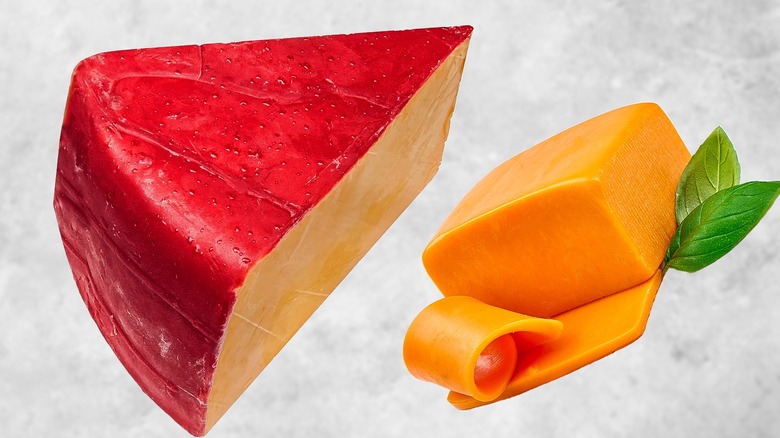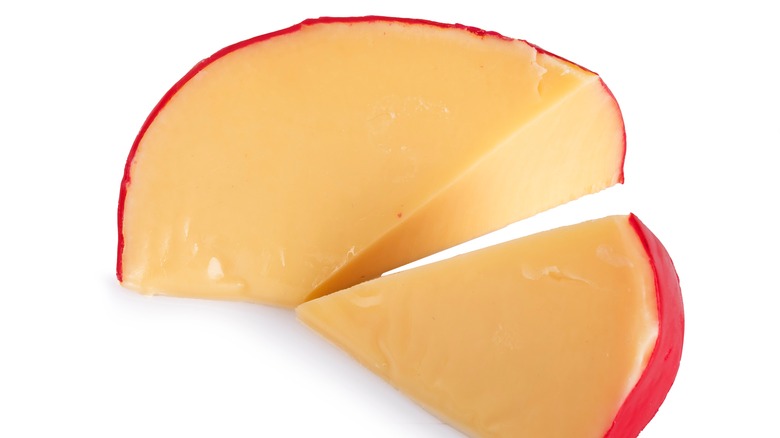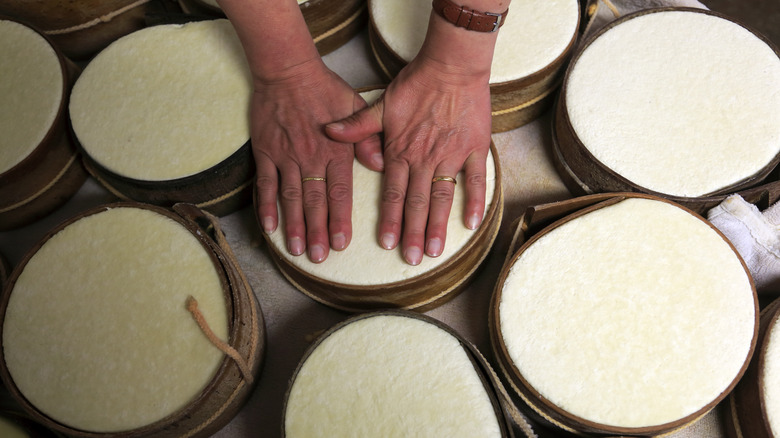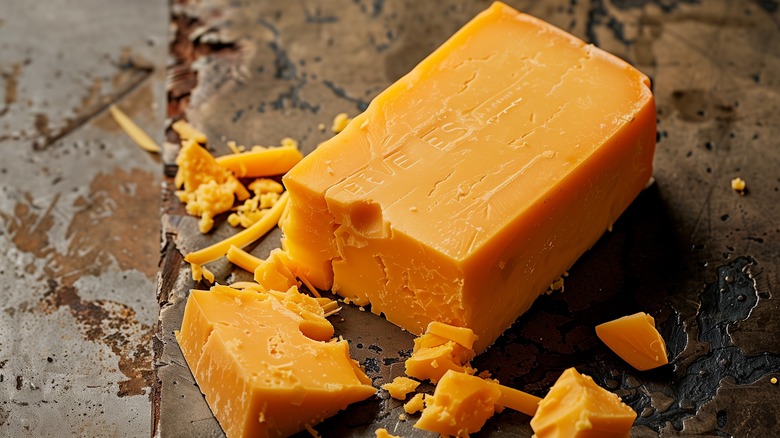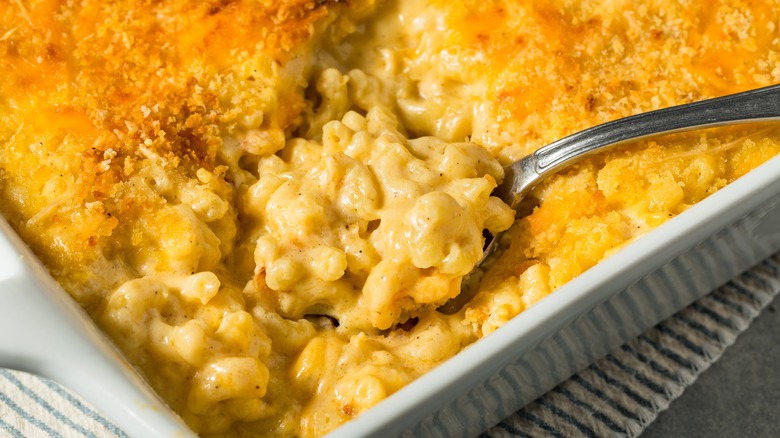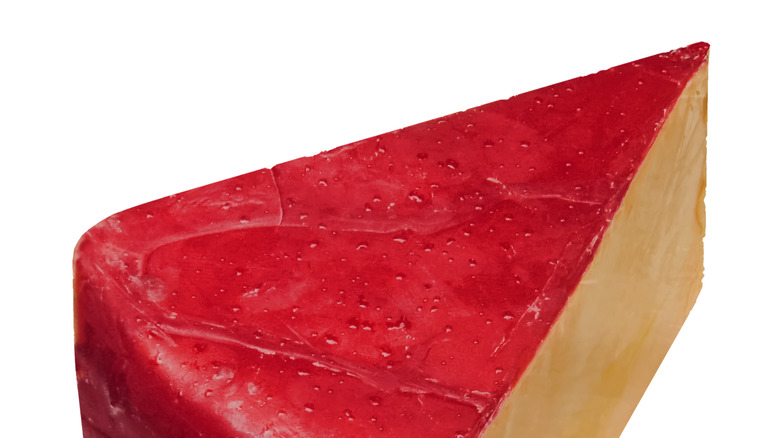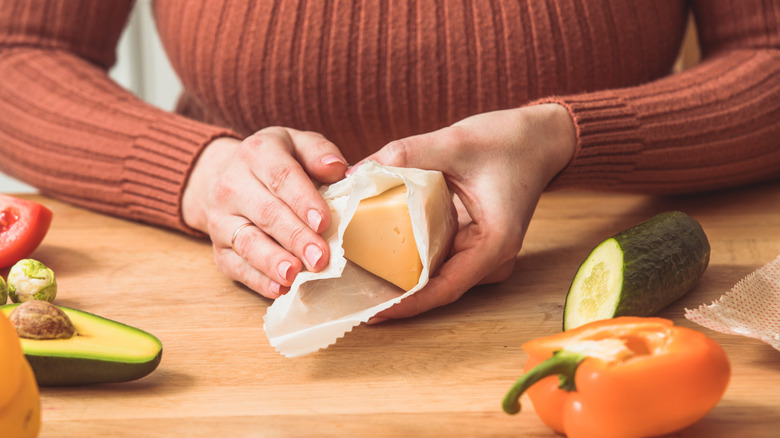Hoop Cheese Is Cheddar's Cousin You Might Not Know About
When you think of traditional Southern cuisine, foods such as creamy grits, buttermilk biscuits, and classic fried chicken likely spring to mind. Yet there's one staple of the South you may not know about: hoop cheese. Often described as cheddar-like, hoop cheese boasts a simple, uncomplicated, mild flavor worthy of admiration.
Whether you enjoy it as a snack, add it to your favorite sandwich, or melt it into grits, hoop cheese is the American cheese variety everyone should try. Known for its bright red or black wax rind, you've likely seen wheels or wedges of hoop cheese on the counters of small shops and markets if you've spent any time down South. Hoop cheese is typically limited to stores in its native region, after all, as the very specific techniques required to make it (and subsequent short shelf life) has kept it from going mainstream.
I grew up noshing on white bread smothered with melted (and slightly blistered) slices of hoop cheese. Though my instructors at culinary school sang the praises of various cheeses, nothing compares to the creaminess of the hoop cheese-laden macaroni and cheese of my youth, or its slightly salty taste when stacked on a cracker. Additionally, as a personal chef, I've served clients dishes like broccoli cheddar soup and cheddar tomato pie made with hoop cheese — ferried to me from relatives who still live in hoop cheese country — instead of cheddar. Here's what you might not know about hoop cheese.
What is hoop cheese?
Hoop cheese is a fresh and unaged dairy product made from cow's milk. It's also a culinary time capsule to the days of mom-and-pop general stores who made the cheese in-house at each location. For us cheese lovers who grew up choosing between the red and black wax-wrapped wedges in country stores, hoop cheese is a tasty reminder of simpler times. It's both a delicious dairy product and a cheesy bit of nostalgia.
No preservatives or other flavorings are added to hoop cheese, which gives it the mild, milky taste it's known for. Additionally, hoop cheese derives its name from the rounded molds used when making it, which provide its trademark shape. The term hoop is also a throwback to the early days of cheesemaking when farmers used whatever was readily available to shape their cheese — even unconventional items like wooden hoops. Eventually, the hoops became synonymous with the cheese and process, and the name stuck over time.
What does hoop cheese taste like?
One reason hoop cheese is so revered by those who've had the delicious pleasure of trying it is its taste. Although there may be some variation, hoop cheese is known for its mild, fresh flavor. It's more dairy-forward than other cheeses, likely because it doesn't contain many ingredients and isn't typically aged, allowing the flavors from the cow's milk to shine. Additionally, there are two varieties of hoop cheese available, with the color of their wax rind largely setting them apart.
Red rind hoop cheese is the most common variety. It's somewhat salty and mild, developing a slightly sharp, understated nutty tone. Black rind hoop cheese, meanwhile, has a stronger and more vibrant flavor, as well as a firmer texture than the red rind variety. If you can find it, the black rind variety will elevate your pimento cheese spread to new heights of deliciousness.
How is hoop cheese made?
Hoop cheese is made by heating raw cow's milk, then adding rennet or cultures to make the milk curdle. When curds form, they're cut into smaller pieces and drained to separate the whey from the curds. The curds are then placed in round molds (or hoops) lined with cheesecloth and pressed to get rid of any remaining whey. The resulting cheese is wrapped in wax before it's sold.
The process required to make hoop cheese is one of the primary reasons why it's not readily available outside of the southern United States. After all, unlike most other cheeses, hoop cheese is made exclusively with cow's milk. No salt or additional cream is included during its production, either, which is what sets hoop cheese apart from farmer's cheese. Furthermore, the lack of salt means hoop cheese has a much shorter shelf life than other cheeses once it's sliced.
Since producing hoop cheese on a large scale on par with more widely available cheeses (like cheddar) has proven difficult, most hoop cheese is still produced in the South. However, it can be found in other parts of the country, often at creameries run by cheesemakers or families with roots in the South.
How is hoop cheese different from cheddar?
Hoop cheese and cheddar are frequently compared, with some hoop cheese even labeled as "hoop cheddar cheese" or "mild cheddar hoop cheese" in some cases. Despite this, hoop cheese and cheddar are not the same thing. While they're both members of the same cheddar family, there are several differences in terms of texture, taste, and how each cheese is made.
Cheddar is known for its firmer texture and sharper flavor. Additionally, it's made by pressing the stacked curds to eliminate as much whey as possible, which makes the cheese dense. The curds are then broken down into smaller pieces that are placed in molds, where they're drained even more and allowed to age. Cheddar is aged for a minimum of two months for milder varieties, and can be aged for years depending on the type and sharpness.
Hoop cheese isn't pressed nor is it aged, which is responsible for its milder flavor and soft, crumbly texture. Additionally, unlike hoop cheese, there are no requirements or restrictions regarding the type of dairy used or addition of salt with cheddar cheese.
Where can you buy hoop cheese?
Hoop cheese is a treat, not just because of its delightful taste and creamy texture, but because it can be hard to find. If you're shopping for cheese in the South where it's readily available, finding hoop cheese is no big deal. You'll likely spot its bright red or black rind in any country store or mom-and-pop establishment; some southern gas stations even sell hoop cheese, as well. However, finding hoop cheese in other parts of the country isn't as easy. In fact, it can be like finding a culinary needle in a haystack.
Since the process used to make hoop cheese is difficult to standardize for mass production, only a handful of producers appear to offer it outside of the South. Thankfully, online shopping makes it easier to find and purchase hoop cheese from these cheesemakers. You may miss the charm of chatting with staff about how the cheese is made and the best way to enjoy it, but having it delivered right to your door helps make up for the lack of nostalgia.
Stripling's General Stores in Georgia makes hoop cheese and sells it online. Additionally, Gourmet Foods International sells and ships hoop cheese from New Bridge Cheese (one of a handful of producers not located in the south), while cheese lovers can purchase hoop cheese online from North Carolina's Ashe County Cheese store, as well.
How to cook with hoop cheese
Hoop cheese has the ability to add creaminess to foods without altering the overall flavor, so you can add it to dishes for a velvety finish. Want a grilled cheese with a cheese pull like no other, for instance? Use hoop cheese. Simply put, it's an excellent melting cheese, which is why so many families (mine included) add it to their grits and scrambled eggs.
Adding hoop cheese to a fabulous yellow squash casserole is another simple way to transform a recipe from good to great. Squash doesn't have a very bold flavor profile on its own, yet hoop cheese is so mild that it allows the squash to take the spotlight. Additionally, in eastern North Carolina, hoop cheese is the star ingredient in the area's treasured cheese biscuits. These biscuits are like no other, with generous chunks of hoop cheese wrapped in biscuit dough and baked to perfection. They're so full of cheese it's hard to tell if you're eating a biscuit filled with cheese, or hoop cheese with a little biscuit.
How to serve hoop cheese
Like many other cheeses, hoop cheese is best served at room temperature. Traditional ways to serve it include slicing it thinly and adding it to sandwiches or cutting it into cubes to enjoy as a snack. One of my fondest cheese memories is sitting on the front porch with my grandfather while he shaved off strips of hoop cheese for me with his pocketknife. In other words, no fancy preparation necessary.
Hoop cheese's mild, slightly salty flavor is the perfect addition to a cheese and charcuterie board, where you can pair it with crackers, slices of hearty bread, and fruits like apples and pears. You can also serve it as a dessert cheese along with melons and fresh berries for a deliciously balanced bite. Additionally, no conversation about cheese and southern food is complete without pimento cheese, and the southern staple — which is part dip, part spread — is made even better with the addition of shredded hoop cheese.
How to store hoop cheese
Air flow is an important factor in properly storing cheese, and hoop cheese is no exception. Cheese needs some air to breathe, but too much air can cause it to dry out or end up exposed to bacteria. To avoid this problem, wrap your hoop cheese in parchment paper or wax paper. Then, either wrap it loosely with plastic wrap or place it in an unsealed plastic bag in the refrigerator. Store the wrapped cheese in the crisper drawer, away from foods with strong odors the cheese might absorb.
If you're lucky enough to buy an entire wheel of hoop cheese, the cheese's wax coating will serve as a layer of protection from excess air, while keeping the cheese safe from bacteria. If you pick up a vacuum-sealed smaller wedge of hoop cheese, it will stay fresh in your fridge for months as long as the seal remains intact. Once the seal is broken, the cheese will last one or two weeks if properly wrapped and refrigerated.
